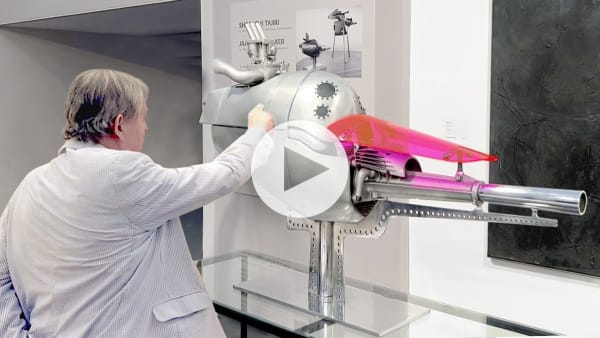Jaap Wagemaker Dutch, 1906-1972
We cannot take anything away from the earth; we can only change its shape.
Jaap Wagemaker is the Netherlands' foremost representative of the international movement known in the nineteen-fifties and sixties as Informal Art and more specifically by its technical classification: 'matter painting'.
The origins of this movement lie in the artistic developments in Paris after 1945. A free art form originates here, a lyrical abstraction that expressly breaks away from pre-war realism. In the Netherlands the CoBrA group was part of this movement of artists painting in a lyrical-abstract manner.
In the nineteen-fifties an alternate movement emerged out of this free and often colourful abstraction, which became known as 'Informal Art'. Any semblance of recognisably figurative forms and elements disappear from the painting and the material, the matter, becomes a crucial means of expression for a small number of like-minded artists in Europe such as Alberto Burri in Italy, Antonio Tapiès in Spain, Emil Schuhmacher and Karl-Fred Dahmen in Germany, Jean Fautrier and Jean Dubuffet in France and Wim de Haan, Bram Bogart and Jaap Wagemaker in the Netherlands.
The young Wagemaker goes to the School for Architecture, Decorative Arts and Crafts in his hometown of Haarlem with the aim of becoming a decorator.
Nonetheless, notably after visiting Paris several times as a young man in the nineteen-twenties and thirties, he decides to become a painter. He feels drawn to the expressionism of Constant Permeke and Herman Kruyder with his vigorous forms and earth colours. He continues to develop after the war and for a brief period the colourful idiom of CoBrA can be seen in his paintings. He spends some time in Paris in the studios on the Rue Santeuil, where his fellow Dutchmen Karel Appel, Corneille and Bram Bogart also live.
Wagemaker’s first experiments with a freer, more robust use of materials dates from 1956, after which he rapidly establishes his reputation as a 'matter painter'. He finds fame in Germany in particular and Jaap Wagemaker exhibits in the major galleries. Museum Boijmans Van Beuningen in Rotterdam acquires the first of his works in 1956 and his debut exhibition in the Stedelijk Museum Amsterdam is in 1957. The Rotterdam gallery-owner Hans Sonnenberg was a significant ambassador for Wagemaker in the Netherlands. His exceptional eye for new and international developments means that it is Hans Sonnenberg who presents the Italian artist Manzoni in the Rotterdamse Kunstkring in 1959 and brings his revolutionary work together with that of Jan Schoonhoven and ….Jaap Wagemaker, among others.
In 1960 Jaap Wagemaker wins the 'Premio Marzotto' a famous Italian award of the time. The prize and exhibition contribute enormously to his international reputation. Wagemaker takes part in the exhibition 'The Art of Assemblage' in the New York Museum of Modern Art in 1961. In addition the MoMA buys one of his works. He is awarded the prestigious Talens Prize in the Netherlands in 1962. Major Dutch and international museums acquire his work. In 1962 he participates in the Venice Biennale. In 1965 he receives the "Association internationale des critiques d'art", the "Prix de la Critique" and in 1966 the inaugural 'Staatsprijs voor Beeldende, Kunsten en Architectuur'.
As an enthusiastic collector of ethnographic art and also as a traveller and photographer Jaap Wagemaker travels frequently to North Africa and the Near East. He emphatically and visibly processes the impressions from these trips and the inspiration from his ethnographic art collection in his matter paintings and assemblages.
Jaap Wagemaker dies prematurely and unexpectedly during a hip operation in 1972.
“”We cannot take anything away from the earth; we can only change its shape”. It is this statement by Albert Einstein, once quoted by Wagemaker during an interview, which to a great extend formed the core of Wagemaker's artisthood. Sand, fibres, slate, ashes, bones, metals, wood.
Jaap Wagemaker did not add anything to the earth, nor did he take anything away from it. He only changed its shape.”
(from S. den Heijer, M. van der Knaap, Jaap Wagemaker, schilder van het elementaire, Zwolle 1995, p. 250)
-

Tajiri / Wagemaker
14 Nov - 15 Dec 2023Celebrating the centennial of Shinkichi Tajiri (b. 1923 Los Angeles, USA – d. 2009 Baarlo, The Netherlands), The Mayor Gallery continues it's Frieze Masters presentation exhibiting at our gallery a...Read more -

Frieze Masters
Tajiri / Wagemaker 11 - 15 Oct 2023“We cannot take anything away from the earth; we can only change its shape.” - Jaap Wagemaker To celebrate the centennial of Shinkichi Tajiri(b. 1923 Los Angeles, USA – d....Read more -

In Real Life
9 Jun - 29 Jul 2021After months of only following the artworld through our screens, many of us now miss the experience of seeing art in person. This Summer The Mayor Gallery celebrates that irreplaceable...Read more -

Earth & Light
Wagemaker & Schoonhoven 20 Oct - 4 Dec 2020The Mayor Gallery presents in collaboration with Borzo Gallery, Amsterdam, a joint exhibition of two principal Dutch artists of the 20th Century; Jaap Wagemaker (b. 1906 Haarlem – d. 1972...Read more
-

Walk-Around | Frieze Masters 2023
With James Mayor October 13, 2023Click below to view nn in depth tour of our stand at Frieze Masters 2023 conducted by James Mayor. Fair dates: 11 - 15 October...Read more -

Frieze Masters
Tajiri / Wagemaker October 2, 202311 - 15 OCTOBER 2023 STAND D12 ANNOUNCING participation in this year's Frieze Masters in collaboration with BorzoGallery and Matthijs Erdman a duo presentation of...Read more











